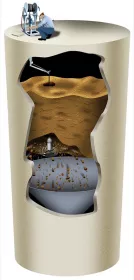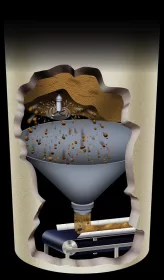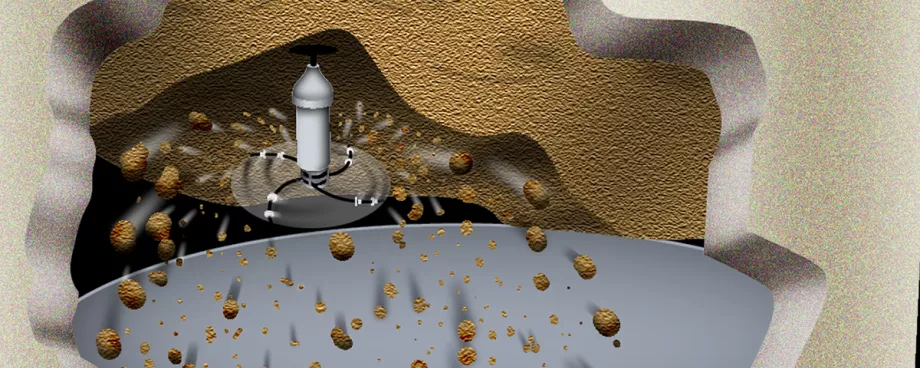
One of the United State’s leading manufacturers of cement and other building materials has overcome a severe blockage of Type I cement in its 80000 short ton (approx. 72000 tonnes) capacity storage silo by employing an innovative pneumatic cleaning technology that was remote controlled from outside the domed structure. The Eagle Materials Illinois Cement facility experienced the blockage when a support cable on the reclaim screw conveyor came loose, sending thousands of pounds of material down into the silo at one time. But with the unique whip design of the cleaning equipment and some round-the-clock dedication from a Martin Engineering crew, the accumulation was efficiently cleared and loaded out, allowing repair personnel to set up a crane and lift the auger back into position.
The unique design of the equipment allowed it to be lowered from the top through a manhole opening, and although the crew was on-site around the clock for nearly a month, the material could be loaded out with normal operating procedures. “During the process, we were able to use our auto load-out system from the bottom of the dome, because the material being knocked down fell primarily in the centre;’ recalled Chief Chemist and Quality Control Manager Kevin Jensen. ‘There was no need to transfer cement in the tunnel, and that helped minimize the disruption:’
Founded in 1964, Eagle Materials is one of the nation’s largest cement providers, with four plants supplying a combined total of about 4 million short tons (approx. 3.6 million tonnes) annually. The company’s Illinois Cement facility in LaSalle manufactures approx. 1.1 million short tons (approx. 1 million tonnes) of that total each year.
A Massive Task
Like most cement manufacturers, the plant uses large storage vessels to hold finished material until it’s ready for shipment. At the LaSalle facility, the domed storage unit is 99 ft (approx. 30 m) tall and 186 ft (approx. 56 m) in diameter.

During the course of normal operations, the cable connectors on the reclaim screw worked themselves loose, causing the auger to fall onto the pile and halting the flow of material. The only way to rectify the situation was to position a crane over the top and lift the conveyor out, so the cable could be reattached. But to do that, operators first needed to clear out enough material to access the disabled equipment, a massive task in light of the nearly full dome.
“Our first step was coming up with a plan to tackle the load-out job,” recalled Chief Chemist and Quality Control Manager Kevin Jensen. “We needed to remove a significant amount of material in order to make the repair, and there was just no easy way to go about it.”
Jensen contacted Martin Engineering, Neponset (IL), USA, for assistance, and technicians were on site to inspect the situation the next day. They reviewed the options and determined that the best approach was to employ the Martin Heavy Duty Whip, one of several technologies making up the company’s Silo Solutions product line.
No Need for a Man Inside
Powered by compressed air, the Whip’s patented gyro motor can use a variety of flails and cutting edges to knock down accumulated material without damaging storage vessels. Abrasion-resistant steel chain is best suited for most applications, with non-sparking brass chain for combustible materials. Urethane flails can also be employed to protect lined vessels that could be susceptible to damage from metal tools.

“With this technology, there’s no need to send a man inside and risk injury,” observed Martin Engineering Territory Manager Jim Densberger. “The equipment can be set up quickly outside the vessel, and it’s portable enough to move easily around various bin sizes and shapes.” In most cases, the technique allows material to be recaptured and returned to the material stream.
With safety harnesses in place, Martin Engineering technicians secured the equipment through an access hatch at the top of the dome. Though all of the company’s silo cleaning crews are OSHA and MSHA certified for confined space entry, they instead used remote control from outside the vessel to safely guide the head. The 2-man crew lowered the whip through an opening created in the blockage, then worked their way downward from above, dislodging material as they went. By undercutting the wall accumulation, it eventually began falling in sections from its own weight. The modular boom of the Martin Heavy Duty Whip extends up to 8.5 meters (28 feet) and can clean vessels up to 18 meters (60 feet) in diameter from a central opening of just 450 mm (18 inches).
With the reclaim conveyor repaired and the process back up and running, Jensen was asked to summarize the experience. “The crew’s performance was excellent,” he concluded. “Martin Engineering was very responsive, and provided an innovative solution to the problem. We had good communication throughout, and all work was done in a safe manner.”
About Eagle Materials
Eagle Materials has been manufacturing cement in the US for more than 40 years, with plants strategically located in Illinois, Nevada, Texas and Wyoming. In 2007, the Illinois Cement facility completed a significant upgrade and expansion, facilitating a dramatic improvement in manufacturing capacity, energy consumption and per-unit production costs. Capacity increased to 1.1 million short tons, while the cost structure was reduced by 20%.
■







